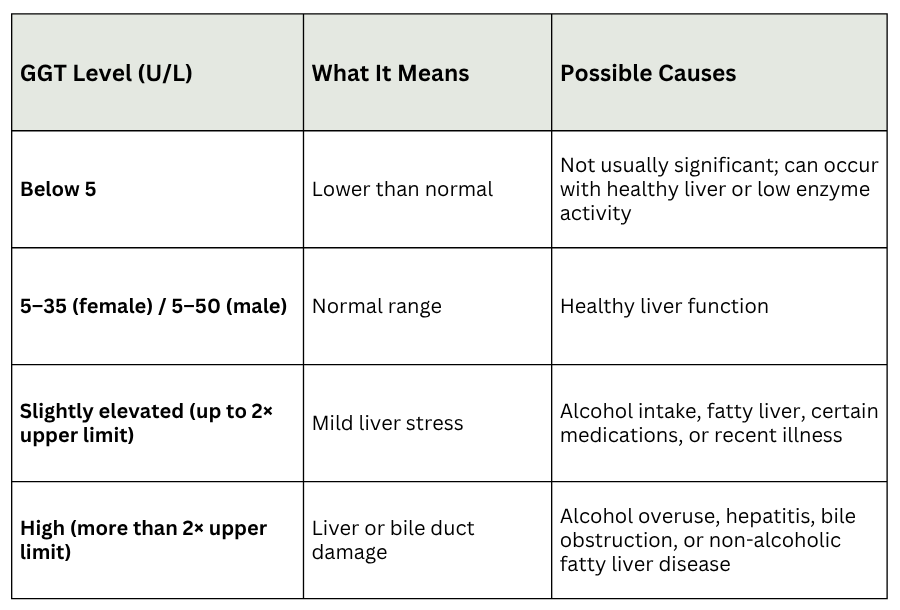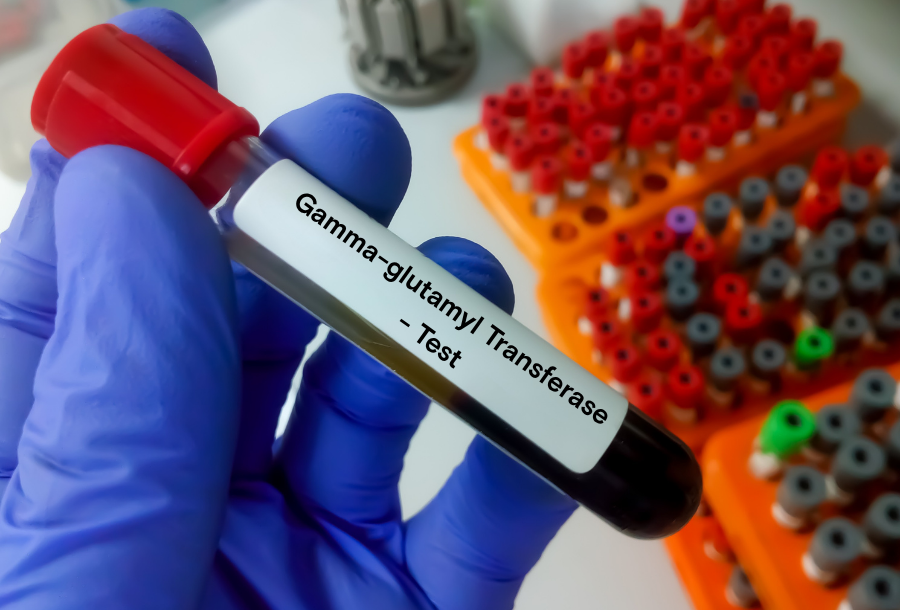Intro offer: $50 off any test using code INTRO50
Choose how you’d like to begin
CGM program
Optimise metabolism in real time with sensors

Advanced Blood Test
Get your baseline health report and personalised plan




Gamma-glutamyl Transferase (GGT) is an enzyme found mainly in the liver that helps break down toxins and medications. A GGT blood test measures the amount of this enzyme in your blood to assess liver function and detect early signs of damage.
Elevated levels are often linked to alcohol overuse, liver inflammation, or fatty liver disease—conditions that can also affect weight regulation and metabolic health. Because GGT is highly sensitive to alcohol and toxins, it’s an important marker for understanding your liver’s overall wellbeing.
This guide explains what it is, how it works, what your results mean, and how you can book a comprehensive blood test to check your Gamma-glutamyl Transferase (GGT).
Gamma-glutamyl Transferase (GGT) is an enzyme your liver uses to process toxins, alcohol, and certain medications. Think of it as one of the liver’s “cleanup crew,” helping to move waste products safely out of your body. When the liver is under stress—such as from alcohol, fatty foods, or certain medicines—GGT levels in your blood can rise, signaling that your liver may be working harder than usual.
Doctors use the GGT blood test to check how well your liver is functioning and to help find the cause of abnormal liver enzyme results. High GGT levels don’t always mean serious disease, but they often point to lifestyle factors or liver strain that can improve with changes in diet, exercise, and alcohol habits.
Quick facts:
Keeping your GGT within a healthy range supports better liver function and overall metabolic balance.
Gamma-glutamyl Transferase (GGT) plays a crucial role in liver detoxification and metabolic health. Because it is very sensitive to alcohol, medications, toxins, and fat accumulation in the liver, it acts almost like a “smoke detector” — small increases often warn of underlying stress before you feel ill. Elevated GGT levels have been linked to conditions such as non-alcoholic fatty liver disease (NAFLD), insulin resistance, metabolic syndrome, and a higher risk of cardiovascular disease. In fact, GGT levels are known to rise in diabetes and NAFLD.
In Australia, national health surveys measure GGT alongside other liver enzymes to monitor the population’s liver health. Globally, GGT has been studied as a predictive marker: in large clinical analyses, GGT often emerges as a top predictor of liver-related outcomes and overall mortality risk.
By tracking your GGT, you gain early insight into your liver’s resilience and metabolic balance. It gives you a chance to address lifestyle, weight, alcohol or medication issues before more serious disease develops — empowering you to support your long-term health and longevity.
A Gamma-glutamyl Transferase (GGT) blood test is often recommended when your doctor suspects liver stress or damage. Because GGT is highly sensitive to alcohol and toxins, even mild increases can signal early liver strain or metabolic issues. You may consider testing if you have:
Regular GGT testing can help detect early changes in liver health, allowing you to take proactive steps toward better metabolic and overall wellbeing.
The Gamma-glutamyl Transferase (GGT) test is done via a standard blood draw. You generally do not need to fast before the test; liver function panels (which include GGT) are routinely collected without special preparation.
However, your doctor may ask you to avoid alcohol or adjust certain medications for a day or two beforehand, since those can influence results.
In Australia, the GGT test cost is usually covered by Medicare when the test is clinically indicated and requested by a GP or specialist under the Medicare Benefits Schedule (MBS).
Most routine liver panels (which include GGT) attract Medicare rebates.If the pathology provider is bulk-billing and all criteria are met, you might pay no out-of-pocket.
If the test is done privately (e.g. part of an advanced panel or at a non-bulk billed lab), there may be a private fee, with Medicare offering a rebate for eligible services. Some labs also apply a small collection fee (e.g. ~$8.50) per invoice.
You can access GGT testing as part of comprehensive blood test panels (e.g. full liver function panels, metabolic health panels) offered by pathology services or health-testing providers. These panels bundle multiple biomarkers (e.g. ALT, AST, ALP) so you get a fuller picture of liver and metabolic health in one session.
This structure ensures that the GGT test is both accessible and cost-effective in Australia, especially when clinically required under Medicare.
Your Gamma-glutamyl Transferase (GGT) results show how well your liver is functioning and whether it’s under stress from alcohol, fat buildup, or toxins. Higher levels usually indicate that the liver is working harder than normal, while very low levels are uncommon and not typically a concern.
Because GGT reacts quickly to lifestyle factors, it’s often used alongside other liver enzymes such as Alanine Aminotransferase (ALT) and Aspartate Aminotransferase (AST) to provide a clearer picture of your liver health.

If your GGT is elevated, your doctor may check related biomarkers such as ALT, AST, or Alkaline Phosphatase (ALP) to identify the source of liver stress and guide further care.
A Gamma-glutamyl Transferase (GGT) test is most useful when interpreted alongside other liver function markers. Because GGT rises in many types of liver stress, comparing it with related enzymes helps identify the specific cause.
For example, Alanine Aminotransferase (ALT) and Aspartate Aminotransferase (AST) indicate liver cell damage, while Alkaline Phosphatase (ALP) helps detect bile duct or gallbladder issues. When both GGT and ALP are high, it often suggests a bile flow problem rather than liver inflammation alone.
Other tests, such as bilirubin, albumin, and total protein, also provide insight into how well the liver processes and clears substances. Together, these biomarkers offer a fuller picture of your liver’s health, helping your doctor pinpoint the cause of any abnormal GGT results and guide the next steps in care.
Understanding your GGT levels in the context of these related tests can reveal early signs of metabolic or liver dysfunction before symptoms appear.
Your daily habits play a major role in maintaining healthy Gamma-glutamyl Transferase (GGT) levels and supporting liver function. Because GGT is sensitive to alcohol, fat intake, and metabolic stress, small, consistent lifestyle changes can make a big difference over time.
These everyday changes help your body’s natural detox processes and protect long-term metabolic health. The best starting point is testing — once you know your levels, you can take personalised steps.
A Gamma-glutamyl Transferase (GGT) blood test measures an enzyme made by the liver that helps break down toxins and medications. It’s used to detect liver stress, alcohol effects, or bile duct problems, often alongside other liver function tests like ALT and AST.
If requested by your GP and deemed clinically necessary, a GGT test is typically bulk-billed under Medicare, meaning no out-of-pocket cost. Without a referral, private pathology labs may charge between $30 and $60.
Yes, a referral from a GP or specialist is usually needed for Medicare coverage. However, some private health services offer direct-access blood test panels that include GGT without a referral.
Yes. The GGT test is listed under the Medicare Benefits Schedule (MBS) and is bulk-billed when medically required and ordered by a doctor.
Yes. GGT testing is safe during pregnancy and may be used to monitor liver function, especially if symptoms like nausea, itching, or swelling occur.
Fatigue, abdominal pain, dark urine, nausea, or yellowing of the skin and eyes (jaundice) may signal liver issues, prompting a GGT test.
Typical GGT levels are 5–35 U/L for women and 5–50 U/L for men. Values above this range may suggest liver stress or alcohol-related changes.
Gamma-glutamyl Transferase (GGT) is a key enzyme that reflects how well your liver handles toxins, alcohol, and everyday metabolic demands. Because it’s highly sensitive to early signs of liver stress, testing your GGT can reveal issues long before symptoms appear. Whether linked to alcohol intake, fatty liver, or certain medications, understanding your GGT levels helps you take proactive steps toward better health.
Monitoring GGT alongside other liver markers like ALT, AST, and ALP gives a more complete view of how your body processes and protects itself from daily stressors. Knowing your levels empowers you to make informed lifestyle choices—such as improving diet, reducing alcohol, and managing stress—that support long-term metabolic and liver health.
Take control of your health today. Sign up for our comprehensive blood test and get clear insights into your Gamma-glutamyl Transferase (GGT) and more than 50 other key markers.
Subscribe to our newsletter & join a community of 20,000+ Aussies

Gamma-glutamyl Transferase (GGT) is an enzyme found mainly in the liver that helps break down toxins and medications. A GGT blood test measures the amount of this enzyme in your blood to assess liver function and detect early signs of damage.
Elevated levels are often linked to alcohol overuse, liver inflammation, or fatty liver disease—conditions that can also affect weight regulation and metabolic health. Because GGT is highly sensitive to alcohol and toxins, it’s an important marker for understanding your liver’s overall wellbeing.
This guide explains what it is, how it works, what your results mean, and how you can book a comprehensive blood test to check your Gamma-glutamyl Transferase (GGT).
Gamma-glutamyl Transferase (GGT) is an enzyme your liver uses to process toxins, alcohol, and certain medications. Think of it as one of the liver’s “cleanup crew,” helping to move waste products safely out of your body. When the liver is under stress—such as from alcohol, fatty foods, or certain medicines—GGT levels in your blood can rise, signaling that your liver may be working harder than usual.
Doctors use the GGT blood test to check how well your liver is functioning and to help find the cause of abnormal liver enzyme results. High GGT levels don’t always mean serious disease, but they often point to lifestyle factors or liver strain that can improve with changes in diet, exercise, and alcohol habits.
Quick facts:
Keeping your GGT within a healthy range supports better liver function and overall metabolic balance.
Gamma-glutamyl Transferase (GGT) plays a crucial role in liver detoxification and metabolic health. Because it is very sensitive to alcohol, medications, toxins, and fat accumulation in the liver, it acts almost like a “smoke detector” — small increases often warn of underlying stress before you feel ill. Elevated GGT levels have been linked to conditions such as non-alcoholic fatty liver disease (NAFLD), insulin resistance, metabolic syndrome, and a higher risk of cardiovascular disease. In fact, GGT levels are known to rise in diabetes and NAFLD.
In Australia, national health surveys measure GGT alongside other liver enzymes to monitor the population’s liver health. Globally, GGT has been studied as a predictive marker: in large clinical analyses, GGT often emerges as a top predictor of liver-related outcomes and overall mortality risk.
By tracking your GGT, you gain early insight into your liver’s resilience and metabolic balance. It gives you a chance to address lifestyle, weight, alcohol or medication issues before more serious disease develops — empowering you to support your long-term health and longevity.
A Gamma-glutamyl Transferase (GGT) blood test is often recommended when your doctor suspects liver stress or damage. Because GGT is highly sensitive to alcohol and toxins, even mild increases can signal early liver strain or metabolic issues. You may consider testing if you have:
Regular GGT testing can help detect early changes in liver health, allowing you to take proactive steps toward better metabolic and overall wellbeing.
The Gamma-glutamyl Transferase (GGT) test is done via a standard blood draw. You generally do not need to fast before the test; liver function panels (which include GGT) are routinely collected without special preparation.
However, your doctor may ask you to avoid alcohol or adjust certain medications for a day or two beforehand, since those can influence results.
In Australia, the GGT test cost is usually covered by Medicare when the test is clinically indicated and requested by a GP or specialist under the Medicare Benefits Schedule (MBS).
Most routine liver panels (which include GGT) attract Medicare rebates.If the pathology provider is bulk-billing and all criteria are met, you might pay no out-of-pocket.
If the test is done privately (e.g. part of an advanced panel or at a non-bulk billed lab), there may be a private fee, with Medicare offering a rebate for eligible services. Some labs also apply a small collection fee (e.g. ~$8.50) per invoice.
You can access GGT testing as part of comprehensive blood test panels (e.g. full liver function panels, metabolic health panels) offered by pathology services or health-testing providers. These panels bundle multiple biomarkers (e.g. ALT, AST, ALP) so you get a fuller picture of liver and metabolic health in one session.
This structure ensures that the GGT test is both accessible and cost-effective in Australia, especially when clinically required under Medicare.
Your Gamma-glutamyl Transferase (GGT) results show how well your liver is functioning and whether it’s under stress from alcohol, fat buildup, or toxins. Higher levels usually indicate that the liver is working harder than normal, while very low levels are uncommon and not typically a concern.
Because GGT reacts quickly to lifestyle factors, it’s often used alongside other liver enzymes such as Alanine Aminotransferase (ALT) and Aspartate Aminotransferase (AST) to provide a clearer picture of your liver health.

If your GGT is elevated, your doctor may check related biomarkers such as ALT, AST, or Alkaline Phosphatase (ALP) to identify the source of liver stress and guide further care.
A Gamma-glutamyl Transferase (GGT) test is most useful when interpreted alongside other liver function markers. Because GGT rises in many types of liver stress, comparing it with related enzymes helps identify the specific cause.
For example, Alanine Aminotransferase (ALT) and Aspartate Aminotransferase (AST) indicate liver cell damage, while Alkaline Phosphatase (ALP) helps detect bile duct or gallbladder issues. When both GGT and ALP are high, it often suggests a bile flow problem rather than liver inflammation alone.
Other tests, such as bilirubin, albumin, and total protein, also provide insight into how well the liver processes and clears substances. Together, these biomarkers offer a fuller picture of your liver’s health, helping your doctor pinpoint the cause of any abnormal GGT results and guide the next steps in care.
Understanding your GGT levels in the context of these related tests can reveal early signs of metabolic or liver dysfunction before symptoms appear.
Your daily habits play a major role in maintaining healthy Gamma-glutamyl Transferase (GGT) levels and supporting liver function. Because GGT is sensitive to alcohol, fat intake, and metabolic stress, small, consistent lifestyle changes can make a big difference over time.
These everyday changes help your body’s natural detox processes and protect long-term metabolic health. The best starting point is testing — once you know your levels, you can take personalised steps.
A Gamma-glutamyl Transferase (GGT) blood test measures an enzyme made by the liver that helps break down toxins and medications. It’s used to detect liver stress, alcohol effects, or bile duct problems, often alongside other liver function tests like ALT and AST.
If requested by your GP and deemed clinically necessary, a GGT test is typically bulk-billed under Medicare, meaning no out-of-pocket cost. Without a referral, private pathology labs may charge between $30 and $60.
Yes, a referral from a GP or specialist is usually needed for Medicare coverage. However, some private health services offer direct-access blood test panels that include GGT without a referral.
Yes. The GGT test is listed under the Medicare Benefits Schedule (MBS) and is bulk-billed when medically required and ordered by a doctor.
Yes. GGT testing is safe during pregnancy and may be used to monitor liver function, especially if symptoms like nausea, itching, or swelling occur.
Fatigue, abdominal pain, dark urine, nausea, or yellowing of the skin and eyes (jaundice) may signal liver issues, prompting a GGT test.
Typical GGT levels are 5–35 U/L for women and 5–50 U/L for men. Values above this range may suggest liver stress or alcohol-related changes.
Gamma-glutamyl Transferase (GGT) is a key enzyme that reflects how well your liver handles toxins, alcohol, and everyday metabolic demands. Because it’s highly sensitive to early signs of liver stress, testing your GGT can reveal issues long before symptoms appear. Whether linked to alcohol intake, fatty liver, or certain medications, understanding your GGT levels helps you take proactive steps toward better health.
Monitoring GGT alongside other liver markers like ALT, AST, and ALP gives a more complete view of how your body processes and protects itself from daily stressors. Knowing your levels empowers you to make informed lifestyle choices—such as improving diet, reducing alcohol, and managing stress—that support long-term metabolic and liver health.
Take control of your health today. Sign up for our comprehensive blood test and get clear insights into your Gamma-glutamyl Transferase (GGT) and more than 50 other key markers.
Get irrefutable data about your diet and lifestyle by using your own glucose data with Vively’s CGM Program. We’re currently offering a 20% discount for our annual plan. Sign up here.

Discover how controlling your glucose levels can aid in ageing gracefully. Learn about the latest research that links glucose levels and ageing, and how Vively, a metabolic health app, can help you manage your glucose and age well.


Delve into the concept of mindful eating and discover its benefits, including improved glucose control and healthier food choices. Learn about practical strategies to implement mindful eating in your daily life.


Understand the nuances of polycystic ovary syndrome (PCOS) testing in Australia, the importance of early diagnosis, and the tests used to effectively diagnose the condition. Also, find out when these diagnostic procedures should be considered.
